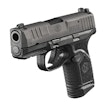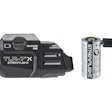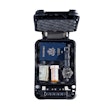There are 400 sworn officers in the Tacoma (Wash.) Police Department. Not all of them are the same size. They don't all have big hands. They don't all have long fingers. And they are not all comfortable holding the same sidearm.
These conclusions recently led the rangemaster of the Tacoma PD to initiate a search for new service weapons to replace the department's aging pistols. That in and of itself is nothing new. Departments occasionally adopt new weapons for their officers.
What's remarkable about the Tacoma decision is that the department's executives gave their firearms experts a free hand to identify the best weapons for the force. Now the process used by the Tacoma PD is serving as a model for other police agencies seeking to change their sidearms or any other issue equipment, gear, or apparel.
Tacoma PD rangemaster Sgt. Mark Jenkins was tasked with finding a pistol to replace the department's standard double-action semi-automatic sidearm. These guns had been in service since the early 1990s, but some Tacoma officers, especially those with smaller hands, said they did not fit well in their palms. In addition, the department's firearm trainers said the long, heavy trigger pulls on the weapons were affecting the officers' aim.
Functional Dimensions
Jenkins' first move was to start collecting pistols for the tests. "I fired off a bunch of letters and eventually we had 37 different guns," Jenkins says. "We did an evaluation that went on for almost a year."
Jenkins and his colleagues went about the process very scientifically. "The first thing we did was determine what constitutes a functional dimension," he says.
A what?
"Functional dimensions," Jenkins explains, "are the dimensions of a particular handgun that you have to be able to get around to make the handgun work."
The functional dimensions include the measurements from the trigger to the backstrap and the width of the grip where a hand fits around it and the trigger finger lays across the grip. Jenkins and his fellow instructors created a chart of measurements and calculations, representing the size of each individual pistol. "We measured every one of the test guns and put that together in the graph," he says. "You can look at that and you can determine if a pistol is too big to hold on to."
Before the many weeks of the process were over, Jenkins and his colleagues had made a very detailed study of the way human anatomy interacts with handguns. "We learned more about hands than we care to know," he says with a grin.
Once the initial study was complete, Jenkins brought in 18 officers-male and female-with different physical characteristics ranging from tall to short, heavy to thin, a "sampling" that represented everybody in the department. He then started putting guns in their hands.
The results were surprising. For example, Jenkins and his colleagues learned that hand size wasn't necessarily the reason why some officers were uncomfortable with certain weapons. "We found that the size of the hand has perhaps less to do with the fit of a pistol in the hand than how thick your hand is," he says.
Jenkins discovered that large officers often have thick hands that do not wrap around a thick pistol very well. "Thick hands have lots of fat that offsets the grip of a pistol," Jenkins explains. "We had one guy who played football in college, an enormous guy, big and strong. He's got so much muscle and meat in his hands that pistols fit him more poorly than a very small, thin woman who had a very long, thin hand, because there was not that much meat in the palm of her hand."
The Museum Piece
Searching for a weapon that would fit the grips of both small-handed officers and big officers with huge meathooks, Jenkins' attention was drawn to the Model 1911 platform, a pistol design that has not been officially adopted by a U.S. metropolitan police department in 50 years.
"My introduction to the 1911 came a couple of years ago," Jenkins says. "I had a hunting rifle that I was not using, and a friend of mine had a 1911 that he wasn't using. He needed a hunting rifle. So we traded. I left that pistol in my gun safe for a couple of months. Then one day I decided to get it out to see what it was like. I picked it up and held it, and fired it. And I realized that it fit in my hand better than any other autoloader I'd picked up and fired.
"But I still thought of it as a museum piece. As time went on, I began looking at 1911s and concluded that not only did they fit well, they seemed to be very reliable. They are easy to work on, and I didn't see any down side to them," he adds.
With the revelation that the 1911 might be the solution to Tacoma's problems, Jenkins brought in some other instructors who did not have experience with 1911s and sent them out to shoot a course of fire, including reactive steel targets. "They came back and said, 'Yeah, this is no problem,'" Jenkins says. "And that's why we looked at 1911s, and it's why I encouraged the department to let me look at everything that was out there on the market and not limit us to double-action-only autos, or traditional double-actions, or any particular make, model, or type of handgun."
Distal Joints
Tacoma's administration gave Jenkins its official nod, so he included the single-action 1911 semi-auto in his evaluations. Testing, however, was far from finished. And more functional dimensions had to be considered.
Particularly critical was finger placement on the trigger. "In a perfect world, you want the distal joint of your trigger finger to be in contact with the trigger," Jenkins says. "If it is a short, light trigger, you can get by with having your distal joint on the near side, and if it is a long, heavy trigger then you're going to need to have your finger on the far side."
When Jenkins first entered law enforcement, the standard issue sidearm was a revolver, and he found that with his distal joint on the far side of the trigger, it allowed for more trigger control. "If you can't control the trigger," he explains, "you can't shoot accurately."
For the purposes of their evaluation, Tacoma's test team placed their distal joints directly on the trigger first, and then wrapped their hands around the grip frame of each pistol.
Jenkins was also looking at other elements that indicate that a pistol fits a shooter's hand. "You want the barrel of the gun to be directly in line with the bone structure of your arm, all the way to the shoulder," Jenkins says. He demonstrated this aspect of fitting a gun to a hand by holding a training facsimile of a Glock pistol. By just eyeballing it, you could tell that the Glock didn't fit Jenkins' hand.
But eyeballing wasn't good enough for the actual tests, so Jenkins and his team were much more precise in their calculations. "We bought a tool from a machine shop that measures angles, and we measured the degrees of off-set from the arm to the barrel (when the pistols were held)," he says. All of the officers involved in the testing process were measured for the degrees of off-set when they picked up each of the 37 test guns.[PAGEBREAK]
One-Half Percent
Another step in the evaluation process was to bring in instructors and have them shoot test guns all day long. Hundreds, and sometimes thousands, of rounds were fired through the guns to test their performance.
"We concluded that a pistol should not have more than 1 percent failure rate for any reason," Jenkins says. "And it needed to be able to feed lots of different kinds of ammunition. The testers would document every single problem or malfunction the weapons had and we would track that. There were some pistols that had unacceptably high failure rates. But most were within our standards, which is a one-percent failure rate. The Kimber Model 1911s had about a one-half percent failure rate."
Once the initial testing was completed, then came the "hard part," Jenkins says. "I'm the rangemaster, not the chief of police. We needed to be able to put all of this on paper. Most people are visual learners and that applies to administrators as well. They needed to be able to look at this and see what it was we were talking about."
So, Jenkins assembled graphs and data into a presentation, and took his findings to the department's administration. "We told them that this is what we had found, and this was our recommendation," he says. "We brought the command staff out to the range, gave them a synopsis of what we had done, and what we recommended, and they accepted it."
The recommendation was to give Tacoma officers a choice between the Kimber and the Glock platforms. "I knew that for the majority of the officers," Jenkins says, "they were too young to have been introduced to 1911s in the military. To them, a 1911 was a museum piece. So we gave them the choice, and this had to be a sustainable choice for me."
Three Glock pistols were selected, the Models 21 in .45 ACP, and the 22 and 23 in .40 S&W. Two Kimbers made the cut, the Pro Carry II with a stainless steel slide and alloy frame, and the Pro Carry II HD, with stainless slide and frame, both in .45 ACP.
The next step was even more extraordinary for a police agency. Every officer in the department, including the chief, was brought to the range to test fire all five guns. They spent about 45 minutes shooting, and by the time they were finished, each officer had settled on one of the five weapons and signed a roster indicating his or her choice so there would be no error later when the guns were issued.
Introduction to the 1911
Before Tacoma PD could begin training the approximately 140 officers who had opted for the Kimber 1911s, a training manual had to be written. That project fell to officer J.D. Barrett. He assembled a complete volume that includes work sheets for each officer, lesson plans, diagrams of the pistols, and even a written test.
The Tacoma PD manual is available to any other law enforcement agency interested in the Kimber. Barrett created a CD-ROM with the entire text, and Tacoma is happy to send it out to other departments.
"We put together a packet of all our test data, and I am happy to send the packet to anybody who is interested," Jenkins says. "Sometimes, small departments don't have the personnel to go through that much of a testing process. I am happy to borrow other people's ideas and I am just as happy to let other people borrow from me."
With its officers now trained and qualified, Tacoma is going to carefully monitor the performance of each pistol. That's another reason why Jenkins wanted the agency to buy the guns rather than simply allow officers to purchase their own. This way, he explained, the guns are brought in for routine maintenance, there can be no question about spending public funds to maintain privately owned pistols, and a complete record of the gun's service life can be maintained by department armorers.
The Tacoma PD's experience constitutes a new level of firearms evaluation for an agency of its size. What it learned, and what it will continue learning, should benefit many other departments.
Cocked and Locked
Like all Model 1911s, the Kimber pistols carried by some officers of the Tacoma Police Department are single-action semi-automatics. In order to fire them, a round must be chambered by racking the slide, which cocks the hammer. And since this procedure could cost them their lives in a tactical situation, police and soldiers armed with 1911s carry them "cocked and locked," meaning the hammer is back, a round is in the chamber, and the thumb safety is on. The thumb safety locks the slide and the sear is blocked, preventing the hammer from engaging.
The problem with carrying a "cocked and locked" pistol is not one of safety, but public perception.
To determine the public's response to officers walking around with cocked pistols in their holsters, Tacoma PD rangemaster Sgt. Mark Jenkins sent a motorcycle officer out with a Kimber for a couple of months. He reasoned that traffic officers have many times the number of public contacts that other patrol officers experience, and this would increase the odds someone would notice the cocked and locked 1911.
For months the test officer reported that no one had noticed the cocked gun, including the officers he worked with. According to Jenkins, the only person who took notice of the cocked pistol was a citizen who was a real gun buff who had looked and noticed that he was carrying a 1911 and asked about it. The test convinced Jenkins that the public would accept seeing their police officers carrying the Model 1911 pistols with the hammers back.
To illustrate his point to the chiefs, when command staff came to the range for Jenkins' presentation on the Kimber Pro Carry, he carried a cocked-and-locked 1911 pistol in the classroom. In front of 20 ranking officers, Jenkins delivered his findings, and nobody noticed the gun.
Just Seven Rounds
During training and qualification drills, Tacoma Police Department officers who chose to carry the Model 1911s learned to handle the Kimber Pro Carry HD II starting from the basics. They went through dry-firing, malfunction clearing, cleaning, off-hand draw, speed shooting, tactical and administrative reloads, and more.
Why? Simply because this generation of police has little, if any, experience with the Model 1911 single-action.
Two things officers learned that they had to deal with were the Kimber's comparatively light-4.5- to 5-pound-trigger pull, and the vast difference in magazine capacity. Each Tacoma officer is issued five seven-round Wilson No. 47 magazines, one for the pistol and four spares to be carried in a nylon quad pouch.
On the range, instructors repeatedly cautioned officers to manage their ammunition and change magazines between drills so they would not run dry. It was verbal reinforcement, a reminder that Kimbers are not high-capacity firearms. Most police handguns carry 12 to 15 rounds, depending upon the caliber and model of pistol. And a seven-round magazine is one of the drawbacks to the 1911.
Lower capacity magazines require a change in the shooter's mindset. Tacoma PD rangemaster Sgt. Mark Jenkins says this downward transition in firepower appears to force officers to concentrate on marksmanship even more, making each shot count, and eliminating any "spray-and-pray" tendencies.
Dave Workman is Senior Editor of Gun Week and a nationally published gun writer.












